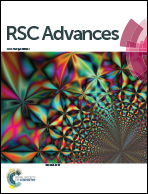Fabrication of a hybrid ultrafiltration membrane based on MoS2 modified with dopamine and polyethyleneimine
Abstract
The hydrophobicity of ultrafiltration membranes is the main cause of membrane fouling and reduced permeability, so it is necessary to improve the hydrophilicity and anti-fouling performance of ultrafiltration membrane materials. MoS2 nanoparticles that were modified with polydopamine (PDA) and polyethyleneimine (PEI), named MoS2-PDA-PEI, were added to fabricate a polyethersulfone ultrafiltration membrane (PES/MoS2-PDA-PEI) for the first time. The effects of modified MoS2 nanoparticles on membrane performance were clarified. The results indicated that the permeability, rejection, and anti-fouling capability of the hybrid PES/MoS2-PDA-PEI membrane have been improved compared with the pristine PES membrane. When the content of MoS2-PDA-PEI nanoparticles in the membrane is 0.5%, the pure water flux of the hybrid membrane reaches 364.03 L m−2 h−1, and the rejection rate of bovine serum albumin (BSA) and humic acid (HA) is 96.5% and 93.2% respectively. The flux recovery rate of HA reached 97.06%. As expected, the addition of MoS2-PDA-PEI nanoparticles promotes the formation of the porous structure and improves the hydrophilicity of the membrane, thereby improving its antifouling performance.



 Please wait while we load your content...
Please wait while we load your content...